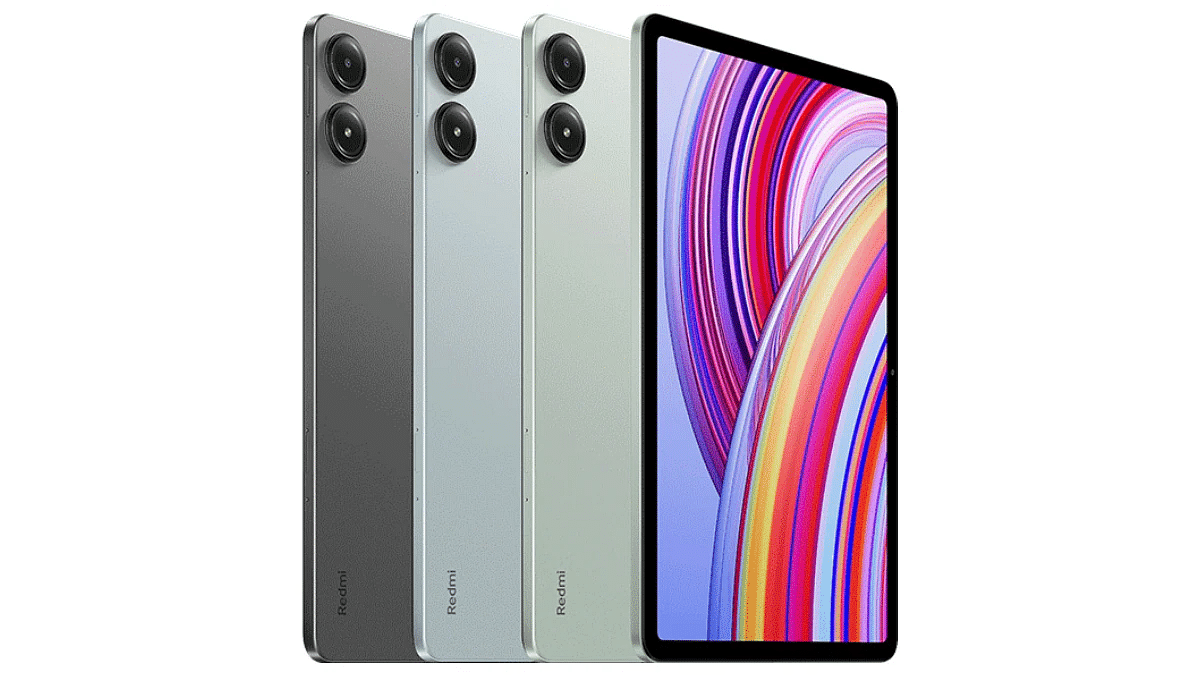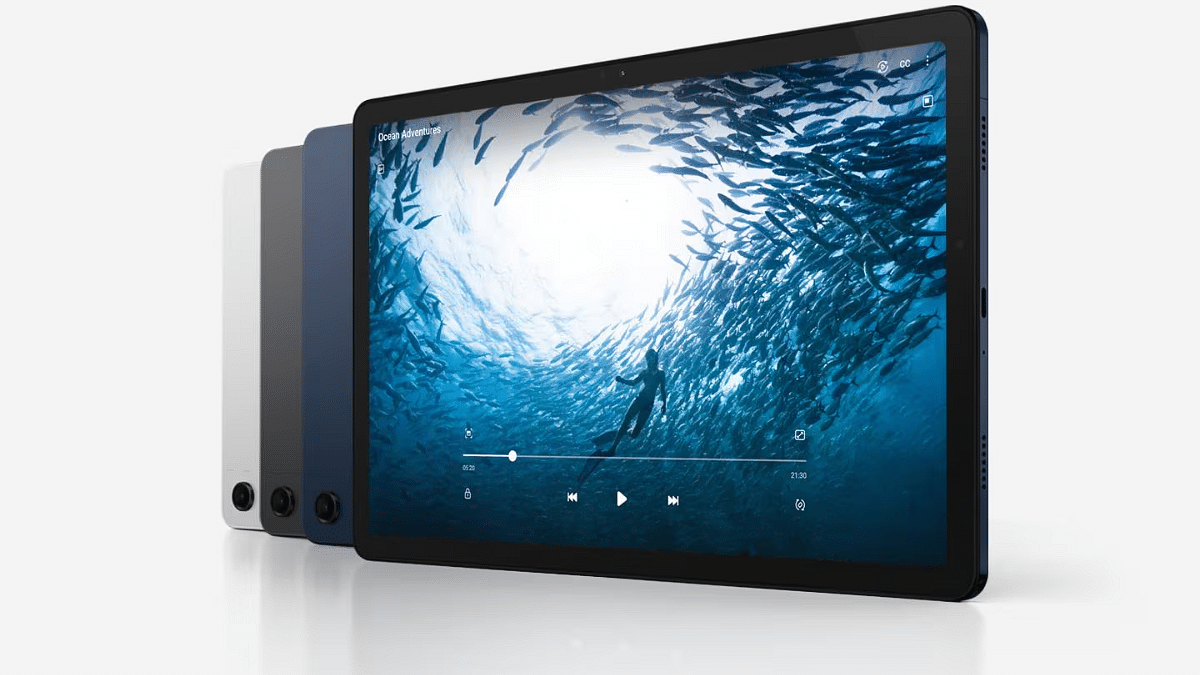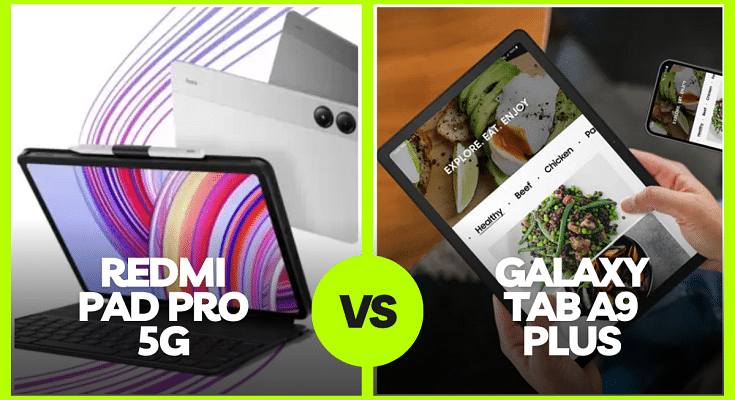Xiaomi and Samsung are going head-to-head in the mid-range tablet market with the Redmi Pad Pro 5G and the Galaxy Tab A9 Plus, respectively. Both tablets offer compelling features, but which one comes out on top? Let’s compare both the devices and see which one best fits your need.
Also Read | Google Pixel Tablet Vs OnePlus Pad Vs Vivo Pad 2: Top Value Flagship Android Tablet
Display

Smooth and colorful images are displayed on the 12.1-inch 2.5K display with a 120Hz refresh rate on the Redmi Pad Pro 5G. It also has a maximum brightness of 600 nits and Gorilla Glass 3 protection. Because of this, it is quite durable and perfect for use outside.
On the other hand, the Galaxy Tab A9 Plus features a slightly smaller 11-inch LCD screen with a 90Hz refresh rate. While it may not match the refresh rate of the Redmi Pad Pro 5G, it still delivers decent performance for everyday tasks.
Performance
Under the hood, the Redmi Pad Pro 5G is powered by the Qualcomm Snapdragon 7s Gen 2 processor paired with an Adreno 710 GPU. It comes with 8GB of RAM and offers storage options up to 256GB, which can be expanded up to 1.5TB via a microSD card. This combination ensures smooth multitasking and ample storage for all your apps and media.
In comparison, the Galaxy Tab A9 Plus is equipped with the Qualcomm Snapdragon 695 chipset, which also supports 5G connectivity. It offers two storage variants: 4GB RAM with 64GB storage and 6GB RAM with 128GB storage. While the processor is slightly less powerful, it still provides a solid performance for most applications.
Camera And Battery

With an 8MP front and rear camera, the Redmi Pad Pro 5G is a good choice for casual photography and video calls. Long usage periods are guaranteed by its large 10,000mAh battery, and you can rapidly top off the battery when needed thanks to the 33W fast charger that is included.
In addition to having an 8MP rear camera, the Galaxy Tab A9 Plus also has a 5MP front camera for better video calls and selfies. It has a smaller 7,040mAh battery, which may not last as long as the Redmi Pad Pro 5G but is sufficient for moderate use.
Additional Features
Both tablets come with Dolby Atmos speakers, providing an immersive audio experience. The Redmi Pad Pro 5G includes an in-display fingerprint sensor, a 3.5mm headphone jack, and a quad-speaker setup.
The Galaxy Tab A9 Plus, while lacking some of these features, supports Samsung’s range of tablet accessories like the Book Cover and Book Cover Keyboard Slim, adding to its versatility.
Price
The Redmi Pad Pro 5G starts at Rs. 24,999 for the 8GB RAM + 128GB storage model, going up to Rs. 26,999 for the 256GB storage variant. With bank offers, the price can be reduced to Rs. 22,999 and Rs. 24,999, respectively.
By comparison, the Galaxy Tab A9 Plus is more reasonably priced, with a starting price of Rs. 18,999. This makes it a desirable choice for anybody looking for a powerful tablet that won’t break the bank.
Also Read | iPad Air 2024 vs. Samsung Galaxy Tab S9: Which Tablet Wins The Showdown?
Final Verdict
| Specs | Redmi Pad Pro 5G | Samsung Galaxy Tab A9 Plus |
| Display | 12.1-inch 2.5K, 120Hz Refresh Rate | 11-inch LCD, 90Hz Refresh Rate |
| Processor | Qualcomm Snapdragon 7s Gen 2 | Qualcomm Snapdragon 695 |
| RAM | 8GB | 4GB / 6GB |
| Storage | 128GB + 256GB | 64GB + 128GB |
| Rear Camera | 8MP | 8MP |
| Front Camera | 8MP | 5MP |
| Battery | 10,000mAh | 7,040mAh |
| OS | Android-based MIUI | Android-based One UI |
| Price (Starting at) | Rs. 24,999 | Rs. 18,999 |
Both the Redmi Pad Pro 5G and Galaxy Tab A9 Plus have their strengths. With its greater refresh rate, bigger battery, and other functions, the Redmi Pad Pro 5G shines and is perfect for hardcore users. In contrast, the Galaxy Tab A9 Plus is ideal for daily usage because it provides balanced performance at a lower cost. Ultimately, the choice depends on your specific needs and budget.
For the tech geeks, stay updated with the latest cutting-edge gadgets in the market, exclusive tech updates, gadget reviews, and more right on your phone’s screen. Join Giznext’s WhatsApp channel and receive the industry-first tech updates.
